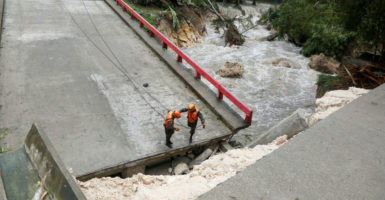Five named storms have already formed in 2016, with Hurricane Earl making landfall last Thursday in Belize. Massive thunderstorms caused extensive damage and death tolls have risen to over 40 people. With September usually a peak month of tropical activity, it is crucial that the U.S. promptly delivers disaster relief when and where it is needed.
Forecasters are now watching the northern Gulf of Mexico near the Florida Panhandle as there is a chance a storm may be brewing closer to home. Ten more named storms, including six hurricanes, are predicted to form during the remainder of the 2016 Atlantic hurricane season.
Historically, state and local governments were responsible for responding to natural disasters, especially smaller ones. Under President Ronald Reagan, the Federal Emergency Management Agency averaged 28 federal disaster declarations a year.
The passage of the 1988 Stafford Act changed the way FEMA responds to disasters. The act made it easier for states to qualify for large amounts of federal aid after a disaster. More specifically, as long as a disaster costs more than $1.41 per capita in a state, totaling less than $1 million for some states, 75 percent or more of response costs are covered by the federal government.
As a result, there is little incentive for states to prepare since FEMA will pay for most of the disaster. The George W. Bush and Obama administrations averaged 130 per year. This trend of federalizing disasters is causing FEMA’s resources to be spread far too thin. When catastrophic disasters do hit, FEMA is not as ready as it should be.
Inevitably, this means Congress must provide FEMA with more money for these disasters, often resulting in bills that are full of pork and unrelated spending. Take, for example, the Hurricane Sandy funding bill, which spent most of its money on projects not related to Sandy.
To stop the over-federalization of disasters and the harm it does to FEMA’s and states’ ability to respond, responsibility of smaller disasters needs to be returned to the states.
Specifically, Congress should limit what disasters can be federalized. For example, by increasing the statewide per capita threshold to $3 per capita, FEMA will not be involved in as many localized disasters, allowing states to play a larger role.
Congress should also limit the cost share that FEMA will pay during declared disasters. Instead of immediately shifting over 75 percent of the costs to the federal government, FEMA should only pay for about 25 percent of the costs of disaster.
Of course, for regional or nationwide catastrophes, a relief provision should provide a higher federal cost-share. FEMA’s resources should become increasingly available as the size and seriousness of the disaster grow.
Such important changes would assure that FEMA has the resources and capabilities to respond when called upon, and the ability to deliver the appropriate amount of aid to disaster victims. With already a few major storms on the books for the 2016 season, Hurricane Earl serves as an important reminder for Congress to rethink disaster management.

























